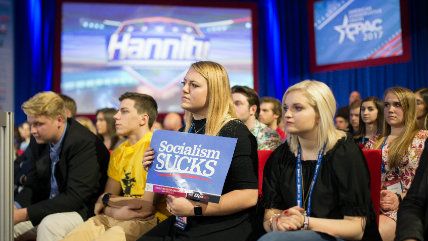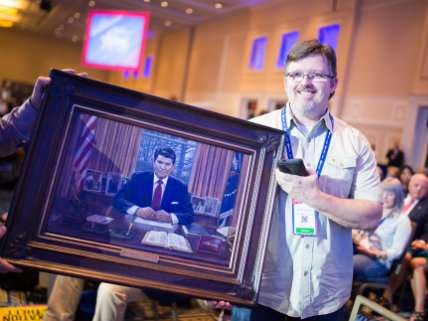A 'Safe Space' for Establishment Conservatism at CPAC 2017
Inside an alternate Republican reality where the alt-right never happened

Sure, there were more "Make America Great Again" hats this year. And Donald Trump's talk was now the main course, rather than an appetizer. But overwhelmingly, there was little at this year's Conservative Political Action Conference (CPAC) to betray that the past year or two of U.S. politics had happened or anything like the "alt right" had ascended. For four days, the massive, annual gathering of right-of-center students, strategists, activists, media, and general GOP enthusiasts functioned mostly as a "safe space" for establishment conservatism and traditional Republican politics.
For one thing, there was nary a Pepe the Frog in sight, nor millennial men sporting the undercut hairstyle so popular among young neo-"deplorables." At CPAC, the hordes of young people packing the expo-hall and after-parties could mostly be found in long-standard young-conservative trappings: navy-blue blazers and bow-ties, shorts dresses with sheer tights and high-heels, khaki pants, polo shirts, elephant-print skirts, and swag t-shirts bearing slogans like "Socialism Sucks."
Even the Breitbart News party Friday night was rather subdued, at least by 2016 standards of absurdity. During the 2016 election, Breitbart emerged as perhaps Trump's biggest cheerleader in the press and the media epicenter of the alt-right. At the Republican National Convention (RNC) last July, a Breitbart-funded party featured far-right figures like anti-Islam activist Pamela Geller and Dutch politician Geert Wilders backdropped by borderline-pornographic "Twinks4Trump" posters and renderings of Trump as Superman, while notorious alt-right web figures like Chuck Johnson, Roosh V, and Lauren Southern roamed the crowd. The whole place was charged with a manic, bizarre, youthful, and sometimes frightening energy.
In comparison, Breitbart's luau-themed CPAC shindig might as well have been a think-tank book party. Journalists from publications like The Hill and The Weekly Standard mingled over cocktails with staffers from D.C. lobbying firms and policy institutes. Sweet-looking old ladies sat eating roast pig and watching smiling hula dancers. The Breitbart staffers on hand wore sensible conference clothing and refrained from shouting wildly about Sharia Law and how feminism is cancer—a notable difference from the RNC party, at which alt-right provocateur and former Breitbart editor Milo Yiannopoulos was the featured speaker. Not even the three-story boat or the arrival of Dog the Bounty Hunter could cut through the stultifying normalcy of the night's event.
The specter of Yiannopoulos—disinvited as a CPAC keynote speaker earlier in the week over comments he made about teens and sex—loomed large in the minds of TV pundits and Twitter conversations going into the conference. Yet the only time I heard him (briefly) mentioned by CPAC speakers or attendees was during a third-day panel on campus politics. And the one mainstage speech explicitly addressing the alt-right (from the American Conservative Union's Dan Schneider) portrayed them as a left-wing fascist movement. Meanwhile, white-nationalist of recent renown Richard Spencer showed up on CPAC's opening morning, but the only folks who flocked to him seemed to be reporters, and within an hour he was kicked out by conference organizers with little fanfare.
The small Spencer kerfuffle aside, CPAC '17 showed little evidence of intra-right drama. Certainly there was nothing like the CPAC "civil war" between more traditional, limited-government conservatives and Trump supporters that some in the media and conservative movement predicted. Trump's Friday morning speech did draw an enthusiastic crowd, but the president's presence was notably absent from the story CPAC speakers and movement leaders told about conservatism.
Even discussions of the 2016 election seemed to largely ignore Trump or his fans as unique phenomenon. Sen. Ted Cruz's campaign strategists gave a session touting the success of their data-driven strategy in Iowa, leaving out the part where this tack failed to match Trump's polar-opposite appeal. A Friday breakout session titled "Revolt of the Deplorables: Inside Election 2016" had seemed like a promising space to find some mention of some of the unique factions, forces, and rhetoric that drove Trump's victory; instead, it featured conservative media insiders dwelling on how the liberal press doesn't get "real" Americans and #NeverTrump conservatives had ineffectual messaging.

At panel after panel, people's talking points—liberals are dumb, conservative are being censored, socialism is evil, guns are good, and God Bless America—could have come direct from many CPAC stages past. Former president Barack Obama and the Affordable Care Act were still a frequent target of ire (Cruz jokingly asked if we could "retroactively impeach" him), as was the supposed sensitivity of college students these days and the liberal bias in the mainstream media. Wayne LaPierre, head of the National Rifle Association, played a 2003 clip of him fighting with a CNN news anchor, which he also showed at CPAC 2016. Limited-government groups and criminal-justice reform advocates plowed on like Jeff Sessions isn't attorney general and Trump doesn't want to spend billions on a border wall.
And the fact that Republicans now dominate Washington seemed who matter little in terms of tailoring CPAC content. Speakers and panelists managed to mock Democratic voters, policies, and leaders (sometimes laudably and sometimes tediously) but failed to focus much on what conservatives could do to make things better.
This is, of course, a trap that many conferences and panels fall into (the amount of substance-lite, lean-in, lip-service-to-intersectionality feminism that plagues prominent panels on the subject could make you weep into your free Bloody Mary). And CPAC is not an academic or professional conference but an event designed to rally broad Republican bases and allow for conservative schmoozing. Some degree of rose-tinted, ra-ra rhetoric is understandable, and probably no more common this year than at conferences past.
Trump's speech was, predictably, it's own uniquely odd and anti-liberty phenomenon. But what's remarkable is how the overall CPAC milieu seemed so little attuned to or affected—visually or rhetorically—by the bizarre past year in American politics, and conservative soul-searching it's spawned. Gadsden flags may have had competition from #MAGA hats at CPAC 2017, but the basic conflation of conservative characters and factions was familiar—the pro-lifers and tax reformers, center-right think tanks and college Republicans, older men in Founding-Father cosplay, groups of frat bros in U.S. flag shorts, hardcore anti-immigration and carceral types (ProEnglish, Sheriff David Clarke), Rick Santorum-style family values crowd, libertarian-leaning millennial groups, smiling ladies at aggressively pink Enlightened Women's Network and Future Female Leaders booths, conspiracy-spouting talk-radio hosts and perfectly polished TV pundits, gun-rights advocates, chubby middle-age couples in slogan t-shirts, and various identity groups bearing signs explicitly announcing their allegiances ("Blacks for Trump," "Transgender Conservatives," "Jews for Trump," etc.),
While the Democrats spent the weekend warring over control of the Democratic National Committee and, more broadly, the future of the party's purpose and coalition, CPAC conservatives seemed emphatically avoidant of anything that looked like big-picture conversations or redefining what it means to be Republican.
So how do we read CPAC: a sign of surprising health in the conservative political coalition, or a carefully curated and sanitized synthesis of it? A safe space for mainstream/establishment conservatives to talk without the distracting din of white nationalists, men's rights activists, Twitter edgelords, and Ann Coulter? The conservative movement's leaders sticking their collective heads in the sand? Tacit approval for "Trumpism," or a rejection of it? A sign—to use two recently popular words—of resistance, or normalization?
I don't presume to know the answers to these questions. But it does seem clear that whatever shake-ups have happened in the Republican coalition, and whatever disproportionate share of online attention and horror the "alt right" might command, much of the machinery of the conservative movement is little touched by it. They are (for better or worse) busy doing their own wonky, weird, intellectual, insane, freedom-promoting, or reactionary but long-established things. Many of these things are not simpatico with small government or libertarian ideals (as Eric Boehm details here), but such has long been the case with right-leaning gatherings, where religious and socially conservative contingents, "compassionate conservatives," national-greatness and neocon types, etc., outnumber those there for fiscal responsibility or getting government out of our lives. Whatever CPAC 2017 did represent, it wasn't a radical departure from the same mixed-bag of limited-government principles, frightening authoritarianism, and performative populist rhetoric that the conference has cultivated for years.


Show Comments (69)